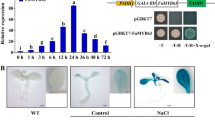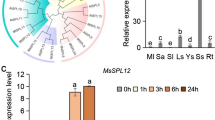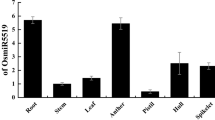Abstract
Key message
SmPPT, which encodes 4-hydroxybenzoate polyprenyl diphosphate transferase involved in ubiquinone biosynthesis, confers salt tolerance to S. miltiorrhiza through enhancing the activities of POD and CAT to scavenge ROS.
Abstract
Ubiquinone (UQ), also known as coenzyme Q (CoQ), is a key electron transporter in the mitochondrial respiratory system. UQ is composed of a benzene quinone ring and a polyisoprenoid side chain. Attachment of polyisoprenoid side chain to the benzene quinone ring is a rate-limiting step catalyzed by 4-hydroxybenzoate polyprenyl diphosphate transferase (PPT). So far, only a few plant PPT-encoding genes have been functionally analyzed. Through genome-wide analysis and subsequent molecular cloning, a PPT-encoding gene, termed SmPPT, was identified from an economically and academically important medicinal model plant, Salvia miltiorrhiza. SmPPT contained many putative cis-elements associated with abiotic stresses in the promoter region and were responsive to PEG-6000 and methyl jasmonate treatments. The deduced SmPPT protein contains the PT_UbiA conserved domain of polyprenyl diphosphate transferase and an N-terminal mitochondria transit peptide. Transient expression assay of SmPPT-GFP fusion protein showed that SmPPT was mainly localized in the mitochondria. SmPPT could functionally complement coq2 mutation and catalyzed UQ6 production in yeast cells. Overexpression of SmPPT increased UQ production and enhanced salt tolerance in S. miltiorrhiza. Under salinity stress conditions, transgenic plants accumulated less H2O2 and malondialdehyde and exhibited higher peroxidase (POD) and catalase (CAT) activities compared with wild-type plants. It indicates that SmPPT confers salt tolerance to S. miltiorrhiza at least partially through enhancing the activities of POD and CAT to scavenge ROS.








Similar content being viewed by others
References
Adly AAM (2002) Oxidative stress and disease: an updated review. Res J Immunol 3:129–145
Altschul SF, Madden TL, Schäffer AA, Zhang J, Zhang Z, Miller W, Lipman DJ (1997) Gapped BLAST and PSI-BLAST: a new generation of protein database search programs. Nucleic Acids Res 25:3389–3402
Araújo WL, Ishizaki K, Nunes-Nesi A, Larson TR, Tohge T, Krahnert I, Witt S, Obata T, Schauer N, Graham IA, Leaver CJ, Fernie AR (2010) Identification of the 2-hydroxyglutarate and isovaleryl-CoA dehydrogenases as alternative electron donors linking lysine catabolism to the electron transport chain of Arabidopsis mitochondria. Plant Cell 22:1549–1563
Ashby MN, Kutsunai SY, Ackerman S, Tzagoloff A, Edwards PA (1992) COQ2 is a candidate for the structural gene encoding para-hydroxybenzoate: polyprenyltransferase. J Bio Chem 267:4128–4136
Avelange-Macherel MH, Joyard J (1998) Cloning and functional expression of AtCOQ3, the Arabidopsis homologue of the yeast COQ3 gene, encoding a methyltransferase from plant mitochondria involved in ubiquinone biosynthesis. Plant J 14:203–213
Bjellqvist B, Basse B, Olsen E, Celis JE (1994) Reference points for comparisons of two-dimensional maps of proteins from different human cell types defined in a pH scale where isoelectric points correlate with polypeptide compositions. Electrophoresis 15:529–539
Burge CB, Karlin S (1998) Finding the genes in genomic DNA. Curr Opin Struct Biol 8:346–354
Büssis D, Heineke D (1998) Acclimation of potato plants to polyethylene glycol-induced water deficit II. Contents and subcellular distribution of organic solutes. J Exp Bot 49:1361–1370
Chang J, Fu X, An L, Chen T (2006) Properties of cellular ubiquinone and stress-resistance in suspension- cultured cells of Chorispora bungeana during early chilling. Environ Exp Bot 57:116–122
Cui G, Huang L, Tang X, Zhao J (2011) Candidate genes involved in tanshinone biosynthesis in hairy roots of Salvia miltiorrhiza revealed by cDNA microarray. Mol Biol Rep 38:2471–2478
Curran KA, Crook NC, Karim AS, Gupta A, Wagman AM, Alper HS (2014) Design of synthetic yeast promoters via tuning of nucleosome architecture. Nat Commun 5:4002
Dai Z, Cui G, Zhou SF, Zhang X, Huang L (2011) Cloning and characterization of a novel 3-hydroxy-3-methylglutaryl coenzyme A reductase gene from Salvia miltiorrhiza involved in diterpenoid tanshinone accumulation. J Plant Physiol 168:148–157
Dcluzeau A, Wamboldt Y, Elowsky CG, Mackenzie SA, Schuurink RC, Basset GJC (2012) Gene network reconstruction identifies the authentic trans-prenyl diphosphate synthase that makes the solanesyl moiety of ubiquinone-9 in Arabidopsis. Plant J 69:366–375
Deng Y, Li C, Li H, Lu S (2018) Identification and characterization of flavonoid biosynthetic enzyme genes in Salvia miltiorrhiza (Lamiaceae). Molecules 23:1467
Dhindsa RS, Matowe W (1981) Drought tolerance in two mosses: correlated with enzymatic defence against lipid peroxidation. J Exp Bot 32:79–91
Draper H (1990) Malondialdehyde determination as index of lipid peroxidation. Methods Enzymol 186:421–431
Du Q, Li C, Li D, Lu S (2015) Genome-wide analysis, molecular cloning and expression profiling reveal tissue-specifically expressed, feedback-regulated, stress-responsive and alternatively spliced novel genes involved in gibberellin metabolism in Salvia miltiorrhiza. BMC Genom 16:1087
Dutta A, Chan SH, Pauli NT, Raina R (2015) HYPERSENSITIVE RESPONSE-LIKE LESIONS 1 Codes for AtPPT1 and regulates accumulation of ROS and defense against bacterial pathogen Pseudomonas syringae in Arabidopsis thaliana. Antioxid Redox Sign 22:785–796
Emanuelsson O, Brunak S, von Heijne G, Nielsen H (2007) Locating proteins in the cell using TargetP, SignalP and related tools. Nat Protoc 2:953–971
Ernster L, Dallner G (1995) Biochemical, physiological and medical aspects of ubiquinone function. Biochim Biophy Acta 1271:195–204
Fan WJ, Zhang M, Zhang HX, Zhang P (2012) Improved tolerance to various abiotic stresses in transgenic sweet potato (Ipomoea batatas) expressing spinach betaine aldehyde dehydrogenase. PLoS ONE 7:e37344
Folkers K, Langsjoen P, Nara Y, Muratsu K, Komorowski J, Richardson PC, Smith TH (1988) Biochemical deficiencies of coenzyme Q10 in HIV-infection and exploratory treatment. Biochem Biophys Res Commun 153:888–896
Folkers K, Hanioka T, Xia LJ, McRee Jr JT, Langsjoen P (1991) Coenzyme Q10 increases T4/T8 ratios of lymphocytes in ordinary subjects and relevance to patients having the AIDS related complex. Biochem Biophys Res Commun 176:786–791
Folkers K, Brown R, Judy WV, Morita M (1993) Survival of cancer patients on therapy with coenzyme Q10. Biochem Biophys Res Commun 192:241–245
Foyer CH, Noctor G (2003) Redox sensing and signaling associated with reactive oxygen in chloroplast, peroxisomes and mitochondria. Physiol Plant 119:355–364
Francin-Allami M, Saumonneau A, Lavenant L, Bouder A, Sparkes I, Hawes C, Popineau Y (2011) Dynamic trafficking of wheat γ-gliadin and of its structural domains in tobacco cells, studied with fluorescent protein fusions. J Exp Bot 62:4507–4520
Fu XZ, Chen CW, Wang Y, Liu JH, Moriguchi T (2011) Ectopic expression of MdSPDS1 in sweet orange (Citrus sinensis Osbeck) reduces canker susceptibility: involvement of H2O2 production and transcriptional alteration. BMC Plant Bio 11:55
Grünler J, Ericsso J, Dallner G (1994) Branch-point reactions in the biosynthesis of cholesterol, dolichol, ubiquinone and prenylated proteins. Biochim Biophys Acta 1212:259–277
Hofgen R, Willmitzer L (1988) Storage of competent cells for Agrobacterium transformation. Nucleic Acids Re 16:9877
Hou X, Shao F, Ma Y, Lu S (2013) The phenylalanine ammonia-lyase gene family in Salvia miltiorrhiza: genome-wide characterization, molecular cloning and expression analysis. Mol Biol Rep 40:4301–4310
Ishizaki K, Schauer N, Larson TR, Graham IA, Fernie AR, Leaver CJ (2006) The mitochondrial electron transfer flavoprotein complex is essential for survival of Arabidopsis in extended darkness. Plant J 47:751–760
Jonassen T, Larsen PL, Clarke CF (2001) A dietary source of coenzyme Q is essential for growth of long-lived Caenorhabditis elegans clk-1 mutants. Proc Natl Acad Sci USA 98:421–426
Kaldis A, Ahmad A, Reid A, McGarvey B, Brandle J, Ma S, Jevnikar A, Kohalmi SE, Menassa R (2013) High-level production of human interleukin-10 fusions in tobacco cell suspension cultures. Plant Biotechnol J 11:535–545
Kroger A, Klingenberg M (1973) Further evidence for the pool function of ubiquinone as derived from the inhibition of the electron transport by antimycin. Eur J Biochem 39:313–323
Levavasseur F, Miyadera H, Sirois J, Tremblay ML, Kita K, Shoubridge E, Hekimi S (2001) Ubiquinone is necessary for mouse embryonic development but is not essential for mitochondrial respiration. J Biol Chem 276:46160–46164
Liu M, Lu S (2016) Plastoquinone and ubiquinone in plants: biosynthesis, physiological function and metabolic engineering. Front Plant Sci 7:1898
Liu L, Zhang Y, Tang S, Zhao Q, Zhang Z, Zhang H, Dong L, Guo H, Xie Q (2010) An efficient system to detect protein ubiquitination by agroinfiltration in Nicotiana benthamiana. Plant J 61:893–903
Liu M, Ma Y, Du Q, Hou X, Wang M, Lu S (2019) Functional analysis of polyprenyl diphosphate synthase genes involved in plastoquinone and ubiquinone biosynthesis in Salvia miltiorrhiza. Front Plant Sci 10:893
Livak KJ, Schmittgen TD (2008) Analyzing real-time PCR data by the comparative CT method. Nat Protoc 3:1101–1108
Lowry OH, Rosebrough NJ, Farr AL (1951) Protein measurement with the Folin phenol reagent. J Biol Chem 193:265–276
Ma Y, Yuan L, Wu B, Li X, Chen S, Lu S (2012) Genome-wide identification and characterization of novel genes involved in terpenoid biosynthesis in Salvia miltiorrhiza. J Exp Bot 63:2809–2823
Mandujano-Chávez A, Schoenbeck M, Ralston L, Lozoya-Gloria E, Chappell J (2000) Differential induction of sesquiterpene metabolism in tobacco cell suspension cultures by methyl jasmonate and fungal elicitor. Arch Biochem Biophys 381:285–294
Marchler-Bauer A, Derbyshire MK, Gonzales NR, Lu S, Chitsaz F, Geer LY, Geer RC, He J, Gwadz M, Hurwitz DI, Lanczycki CJ, Lu F, Marchler GH, Song JS, Thanki N, Wang Z, Yamashita RA, Zhang D, Zheng C, Bryant SH (2015) CDD: NCBI’s conserved domain database. Nucleic Acids Res 43:D222–D226
Møller IM (2001) Plant mitochondria and oxidative stress: electron transport, NADPH turnover, and metabolism of reactive oxygen species. Annu Rev Plant Biol 52:561–591
Moludi J, Keshavarz S, Hosseinzadeh-attar MJ, Frooshani AR, Sadeghpour A, Salarkia S, Gholizadeh F (2015) Coenzyme Q10 effect in prevention of atrial fibrillation after Coronary Artery Bypass Graft: double-blind randomized clinical trial. Tehran Univ Med J 73:79–85
Ohara K, Kokado Y, Yamamoto H, Sato F, Yazaki K (2004) Engineering of ubiquinone biosynthesis using the yeast coq2 gene confers oxidative stress tolerance in transgenic tobacco. Plant J 40:734–743
Ohara K, Yamamoto K, Hamamoto M, Sasaki K, Yazaki K (2006) Functional characterization of OsPPT1, which encodes p-hydroxybenzoate polyprenyltransferase involved in ubiquinone biosynthesis in Oryza sativa. Plant Cell Physiol 47:581–590
Okada K, Ohara K, Yazaki K, Nozaki K, Uchida N, Kawamukai M, Nojiri H, Yamane H (2004) The AtPPT1 gene encoding 4-hydroxybenzoate polyprenyl diphosphate transferase in ubiquinone biosynthesis is required for embryo development in Arabidopsis thaliana. Plant Mol Biol 57:567–577
Premkumar VG, Yuvaraj S, Sathish S, Shanthi P, Sachdanandam P (2008) Anti-angiogenic potential of coenzyme Q10, riboflavin and niacin in breast cancer patients undergoing tamoxifen therapy. Vascul Pharmacol 48:191–201
Ranadive P, Mehta A, Chavan Y, Marx A, George S (2014) Morphological and molecular differentiation of Sporidiobolus johnsonii ATCC 20490 and its coenzyme Q10 overproducing mutant strain UF16. Indian J Microbiol 54:343–357
Rhoads DM, Umbach AL, Subbaiah CC, Siedow JN (2006) Mitochondrial reactive oxygen species. Contribution to oxidative stress and interorganellar signaling. Plant Physiol 141:357–366
Schmelzer C, Lindner I, Vock C, Fujii K, Döring F (2007) Functional connections and pathways of coenzyme Q10-inducible genes: an in silico study. IUBMB Life 59:628–633
Song J, Luo H, Li C, Sun C, Xu J, Chen SL (2013) Salvia miltiorrhiza as medicinal model plant. Acta Pharmacol Sin 48:1099–1106
Swiezewska E (2004) Ubiquinone and plastoquinone metabolism in plants. Methods Enzymol 378:124–131
Swiezewska E, Dallner G, Andersson B, Ernster L (1993) Biosynthesis of ubiquinone and plastoquinone in the endoplasmic reticulum–Golgi membranes of spinach leaves. J Biol Chem 268:1494–1499
Tamura K, Stecher G, Peterson D, Filipski A, Kumar S (2013) MEGA6: molecular Evolutionary Genetics Analysis version 6.0. Mol Biol Evol 30:2725–2729
Thoma I, Loeffler C, Sinha AK, Gupta M, Krischke M, Steffan B, Roitsch T, Mueller MJ (2003) Cyclopentenone isoprostanes induced by reactive oxygen species trigger defense gene activation and phytoalexin accumulation in plants. Plant J 34:363–375
Tran MT, Mitchell TM, Kennedy DT, Giles IT (2001) Role of coenzyme Q10 in chronic heart failure, angina, and hypertension. Pharmacotherapy 21:797–806
Vasil’ev LA, Dzyubinskaya EV, Kiselevsky DB, Shestak AA, Samuilov VD (2011) Programmed cell death in plants: protective effect of mitochondrial-targeted quinones. Biochemistry 76:1120–1130
Wang Y, Hekimi S (2016) Understanding ubiquinone. Trends Cell Biol 5:367–378
Wang M, Deng Y, Shao F, Liu M, Pang Y, Li C, Lu S (2017) ARGONAUTE gens in Salvia miltiorrhiza: identification, characterization, and genetic transformation. Methods Mol Biol 1640:173
Xu H, Song J, Luo H, Zhang Y, Li Q, Zhu Y, Xu J, Li Y, Song C, Wang B, Sun W, Shen G, Zhang X, Qian J, Ji A, Xu Z, Luo X, He L, Li C, Sun C, Yan H, Cui G, Li X, Li X, Wei J, Liu J, Wang Y, Hayward A, Nelson D, Ning Z, Peter RJ, Qi X, Chen S (2016) Analysis of the genome sequence of the medicinal plant Salvia miltiorrhiza. Mol Plant 9:949–952
Yang L, Han H, Liu M, Zuo Z, Zhou K, Lü J, Zhu Y, Bai X, Wang Y (2013) Overexpression of the Arabidopsis photorespiratory pathway gene, serine: glyoxylate aminotransferase (AtAGT1), lead to salt stress tolerance in transgenic duckweed (Lemna minor). Plant Cell Tissue Organ Cult 113:407–416
Zhang L, Yan X, Wang J, Li S, Liao P, Ka G (2011) Molecular cloning and expression analysis of a new putative gene encoding 3-hydroxy-3-methylglutaryl-CoA synthase from Salvia miltiorrhiza. Acta Physiol Plant 33:953–961
Zhang G, Tian Y, Zhang J, Shu L, Yang S, Wang W, Sheng J, Dong Y, Chen W (2015) Hybrid de novo genome assembly of the Chinese herbal plant danshen (Salvia miltiorrhiza Bunge). Gigascience 4:62
Acknowledgements
This work was supported by the CAMS Innovation Fund for Medical Sciences (CIFMS) (2016-I2M-3-016), the National Natural Science Foundation of China (81773836) and the Fund for Postgraduate Innovation in Peking Union Medical College (2015-1007-14). We appreciate Prof. Xian’en Li for kindly providing S. miltiorrhiza plants and Prof. Wei Xiao for kindly providing yeast coq2 mutant.
Author information
Authors and Affiliations
Corresponding author
Ethics declarations
Conflict of interest
The authors declare that they have no conflict of interest.
Additional information
Communicated by Leena Tripathi.
Publisher's Note
Springer Nature remains neutral with regard to jurisdictional claims in published maps and institutional affiliations.
Rights and permissions
About this article
Cite this article
Liu, M., Chen, X., Wang, M. et al. SmPPT, a 4-hydroxybenzoate polyprenyl diphosphate transferase gene involved in ubiquinone biosynthesis, confers salt tolerance in Salvia miltiorrhiza. Plant Cell Rep 38, 1527–1540 (2019). https://doi.org/10.1007/s00299-019-02463-5
Received:
Accepted:
Published:
Issue Date:
DOI: https://doi.org/10.1007/s00299-019-02463-5




